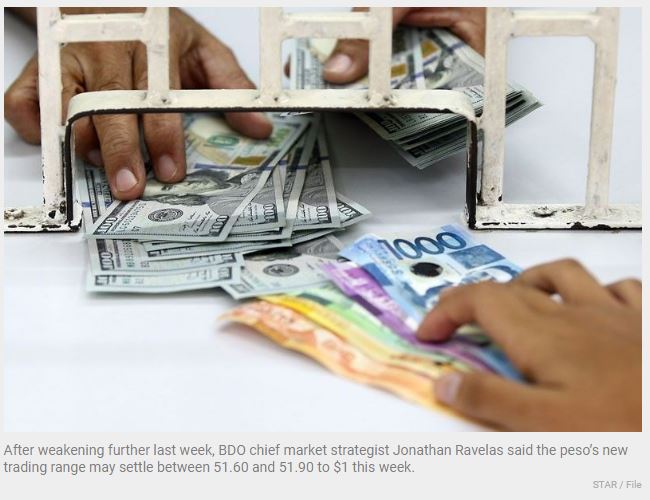Philippines: Peso may weaken to 52 to $1 level
MANILA, Philippines — The peso may weaken further to 52 to $1 as global oil prices continue to rise amid Russia’s invasion of Ukraine and the steady increase in consumer prices.
After weakening further last week, BDO chief market strategist Jonathan Ravelas said the peso’s new trading range may settle between 51.60 and 51.90 to $1 this week.
“The foreign exchange rate at 51.74 signals the assault of the 52 level is underway,” Ravelas said.
The local currency depreciated by 0.40 or 0.8 percent for the first week of March after Russia started its invasion of Ukraine. For 2022, the peso has lost 74.1 centavos or 1.5 percent since closing at 50.999 to $1 in end-2021.
From 51.60 to $1 in March, ANZ Research said the peso may weaken steadily to 52 to $1 in June, 52.25 to $1 in September, and finally to 52.50 to $1 in December mainly due to the hawkish US Federal Reserve.
“The Philippine peso has been trading between 51 and 51.50 since January. In February, it has been among the worst performing currencies in Asia, losing 0.9 percent month to date. The peso’s weakness persisted due to the inflated trade deficit and investors recalibrating positions in the runup to the US Fed rate hike cycle,” the research firm said.
It pointed out that imports continued to outpace exports, leading to a swelling budget deficit, with the country’s balance of payments (BOP) position turning red in January.
“Although the effects of an aggressive US Fed stance are weighing on the peso, it seemed to have turned milder in February, as evidenced by the net equity inflows to the Philippine stock market, month to date,” ANZ said.
With the labor market firming up, ANZ expects remittances from overseas Filipino workers (OFWs) to grow stronger this year.
Another factor is the opening up of the Philippines to fully vaccinated travelers in February, providing much needed support for the peso.
“The worsening balance of payments will keep creating headwinds for the peso, and will see it weakening toward 52.5 by yearend,” ANZ said.
Michael Ricafort, chief economist at Rizal Commercial Banking Corp., said the immediate minor support for the peso is at 51.50, while the resistance level is at 51.80 to 52 against the greenback.
Ricafort said the peso depreciated to its weakest level in more than two years or since closing at 51.79 to $1 on Oct. 9, 2019 as global oil prices lingered at more than 13-year high or since September 2008 and also on higher prices of other major global commodities as Russia’s war with Ukraine continues.
A higher global oil and commodity prices raises the country’s import bill, resulting in higher demand for the dollar which in turn weakens the peso.
Since Russia’s invasion of Ukraine started on Feb. 24, Ricafort said global oil price benchmarks sharply went up by about $25 to $27 per barrel or by at least 26 percent in more than a week to $115 to $123 per barrel levels– the highest in about 10 years.
Ricafort said the conflict and increased sanctions on Russia could also reduce global trade, causing a slowdown in global economic recovery prospects.
“Thus, higher inflation would slow down the economic recovery, amid the reduction in the purchasing power/disposable income amid more spending for oil/energy/other global commodities and to pay for higher prices of affected goods and services,” Ricafort said.
Source: https://www.philstar.com/business/2022/03/07/2165365/peso-may-weaken-52-1-level


 Thailand
Thailand




